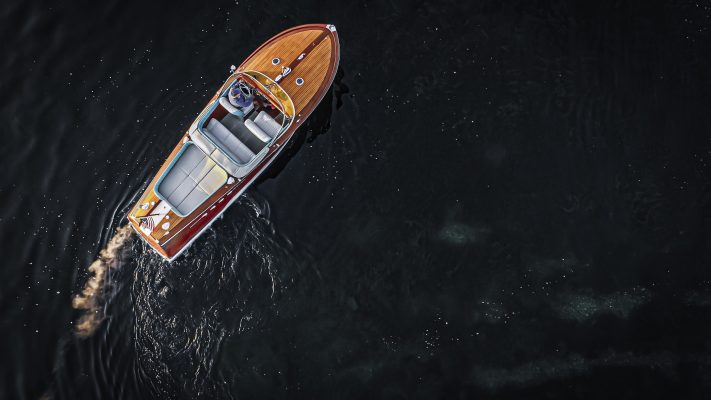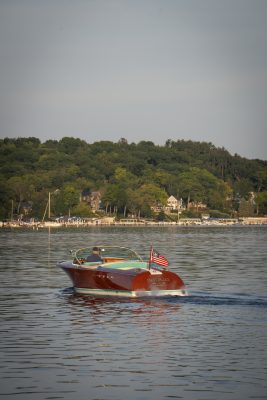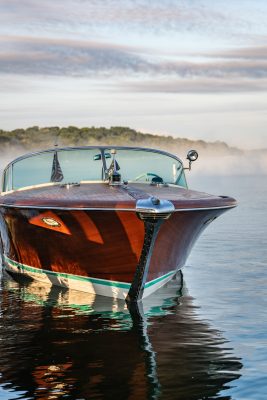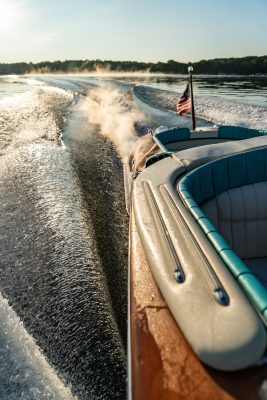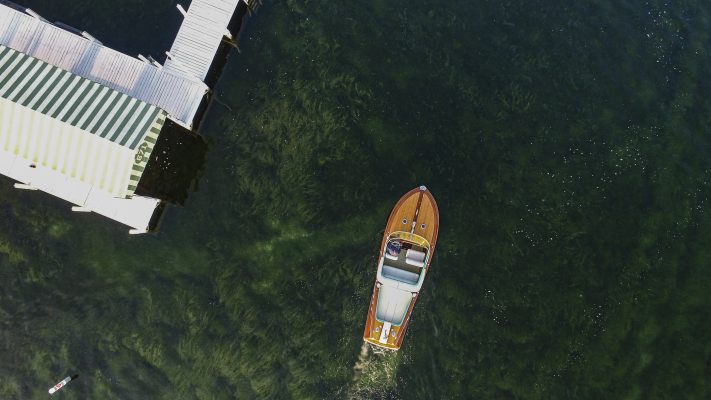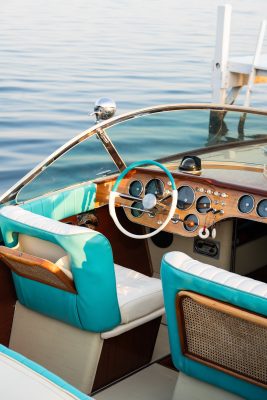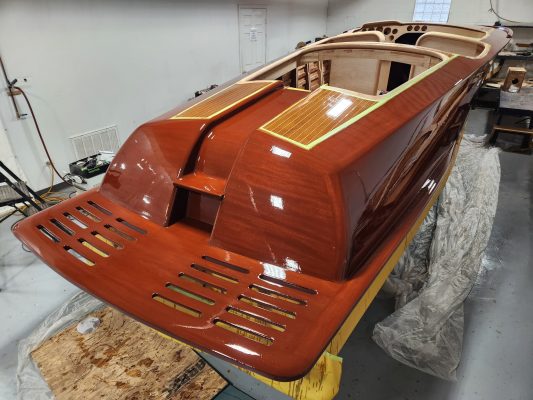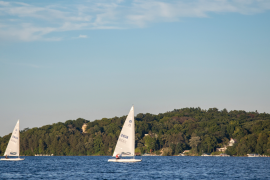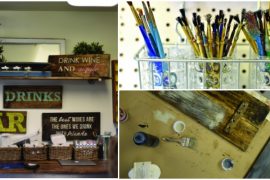Story and Photos by Holly Leitner
One summer evening in 2000, Charlie Johnston sat at the end of his pier watching boats drive by the Geneva Lake shoreline. Evening cruisers bobbed along, but it was one particular boat that turned his head — mahogany beamed in the golden-hour light, and the boat made a gentle hum and left delicately scalloped waves in its wake. Johnston read “Riva” on the side of it.
“It was a floating piece of art,” Johnston says. “I was smitten.” And thus began his quest to know more about this Riva and find his dream boat. What exactly was a Riva? Where were they made? How could he find one? The journey to track down his own floating work of art had begun.
THE RIVA MYSTIQUE
Fifty years earlier, it was a time of rapid economic recovery and a creative flourishing in post-war Italy, epitomized by films like La Dolce Vita; that era of Fiats and Ferraris, bold fashion and Aperol spritz afternoons. The beaches of Italy were Hollywood’s sun-soaked hangout and the new water statement piece were Riva boats. With its finesse, fine lines and luxurious exclusivity, the Riva was the epitome of the era that came to be known as la dolce vita. Stars and royals were among Riva’s owners: Sophia Loren, Brigitte Bardot, Elizabeth Taylor and other stylish icons of the time all owned them.
Today, Riva continues to hold legacy luxury brand status with people with famous last names like Prada, Ferrari, Cartier and Chanel. It continues to turn heads of royalty and stars alike — Sean Connery owned one, and George Clooney famously docks his on Lake Como (the one in Italy, not Walworth County). Due to their perennial appeal, the boats continue to make guest appearances in Hollywood films, including The Italian Job, Ocean’s Twelve and several James Bond movies.
FINDING THE PERFECT BOAT
Back in 2000, Johnston was busy scouring the international boat market for the perfect Riva. After searching for a year and a half through overpriced or worn-out options, he finally found his boat. A 1969 Riva Aquarama with twin, Chevrolet 454 engines, each 350 horsepower. Before purchasing the classic boat, he had it inspected by two wooden boat specialists, and arranged for its restoration by St. Lawrence Restoration in New York.
The Aquarama, that boat that 1960s Hollywood fell in love with, was the flagship model of the Riva line. It was produced from 1950 to 1996, with only 769 Aquaramas ever made. With a short hull, delicately tapered design, seamless mirror finish, gleaming chrome fixtures, glowing aquamarine upholstery and a wraparound, automotive-style windshield, it was the premier luxury boat of its time.
Rivas were made for car lovers, and boasted an oversized steering wheel on the port side. (Most boats feature steering wheels on the starboard side, the opposite of cars in most countries.) The name Aquarama was a nod to the then-cutting-edge American technology called Cinerama, a widescreen process of filmmaking that created an expansive moviegoing experience. Similarly, the Aquarama was designed to evoke a cinematic experience of the water.
THE BIRTH OF RIVA
Although Riva didn’t gain international stardom until the mid-20th century, the company was established along the shores of Lake Iseo in Sarnico, Italy by Pietro Riva in 1842. Riva’s repair business quickly grew into boat building as word spread of the young carpenter’s skills. Each of his next four generations would further evolve the boats and the brand. Pietro’s son Ernesto introduced boats powered by the internal combustion engine. In the next generation, Serafino transitioned from transport vessels to speedboats. But it was the fourth generation, Carlo, that forever established the Riva brand we know today, seducing stars, royalty and wealthy collectors around the world.
In the 1950s in Italy, luxury was booming, and Carlo had a vision: to build a “water-borne sports car.” He wanted to bring boats to the same level as the luxury automotive industry. He was fascinated by American boats, especially those made by Chris-Craft, which was leading the international market for high-end runabouts at that time. Carlo saw the superiority of American-made engines, and opted to install Chris-Craft engines in his boats.
During this decade, Carlo introduced several new models of luxury boats that featured automotive-style dashboards and steering wheels: the Corsaro, the Tritone, the Ariston and the Florida. Prices for these new models soared as people began to covet the sleek design and expert craftsmanship. Soon, Carlo and the Riva brand achieved worldwide stardom.
However, when Riva presented the Aquarama model at the Milan Boat Fair in 1962, the boat builder achieved truly international attention. The Aquarama was a little more than 26 feet in length, made of mahogany with two 8V Chris-Craft engines. Improving on the first model, the Aquarama’s successor would be the Aquarama Super, which could hit a top speed of more than 55 mph with two 320 horsepower engines. The company continued to refine the model, eventually introducing the Aquarama Special.
Riva Aquaramas are identifiable by the distinctive aquamarine color of their seats. Carlo Riva’s granddaughter Lia told a journalist that her mother had inspired the color. “My mother bought a dress in Paris, and my father was so smitten,” she said. “He loved the turquoise so much that he made it a color of the Aquarama’s upholstery.”
Carlo Riva understood luxury branding. He repeated this color scheme everywhere — even the delivery trucks that carried his Rivas to Italian international ports had chrome wheels and the signature aquamarine shade adorning the sides.
A NEW ERA
By the late 1960s, the economic climate of Italy had begun to change. In 1969, Carlo Riva sold his family’s company to an American firm called Whittaker, but remained as a chairman and general manager for a few years. Today, Riva is held by the Ferretti Group, which manufactures luxurious motorboats and yachts.
The classic mid-century models of the Riva company are no longer produced. As a result, these coveted floating masterpieces are rare to find today, driving up their value. Owners hold on to their Rivas for the next generation, realizing they hold prized possessions. Rivas in good condition generally sell in the high six figures.
INSPIRING LOCAL COLLECTORS AND BOAT BUILDERS
Many have been enchanted by Riva boats. In addition to Johnston, three other collectors on Geneva Lake keep Rivas in the water. And local boat builder Lars Bergersen, owner of Bergersen Boat Co. in Lake Geneva, is in the midst of making a Riva replica. For the past three years, Bergersen has been working on a vintage replica in his Lake Geneva-based shop, using original Riva blueprints. The custom order was commissioned by a client who loves the look of a Riva.
“What makes Rivas so special or stand apart is that they have the prettiest lines of any wood boat,” Bergersen explains. “A lot of the manufacturers of new boats, including Chris-Craft, have copied that shape [on newer models] because it’s such an iconic look.”
Bergersen is building the replica out of red mahogany for authenticity. “Riva built the first boat in mahogany and found it was too costly, so they opted for molded plywood veneer from there on out,” he explains. By building the replica out of mahogany, the client will have a Riva that is closest to the original model.
Although this creates an extra challenge for the boat builder, Bergersen says the end result will be worth it for his client. “Rivas perform very well on Lake Geneva,” he points out. “With their size being 27 to 28 feet, it really helps with handling rough water and boat chop.”
Rivas continue to be heralded as some of the most beautiful runabouts of all time. Just to see them skimming Geneva Lake is a glimpse of la dolce vita itself. “When you say, ‘I have a Ferrari,’ [do] you need to say, ‘I have a car’? Everybody knows what a Ferrari is,” explained Alberto Galassi, CEO of The Ferretti Group in a 2022 interview. “A Riva is the same thing. Riva is beyond boating. It is a myth.”

